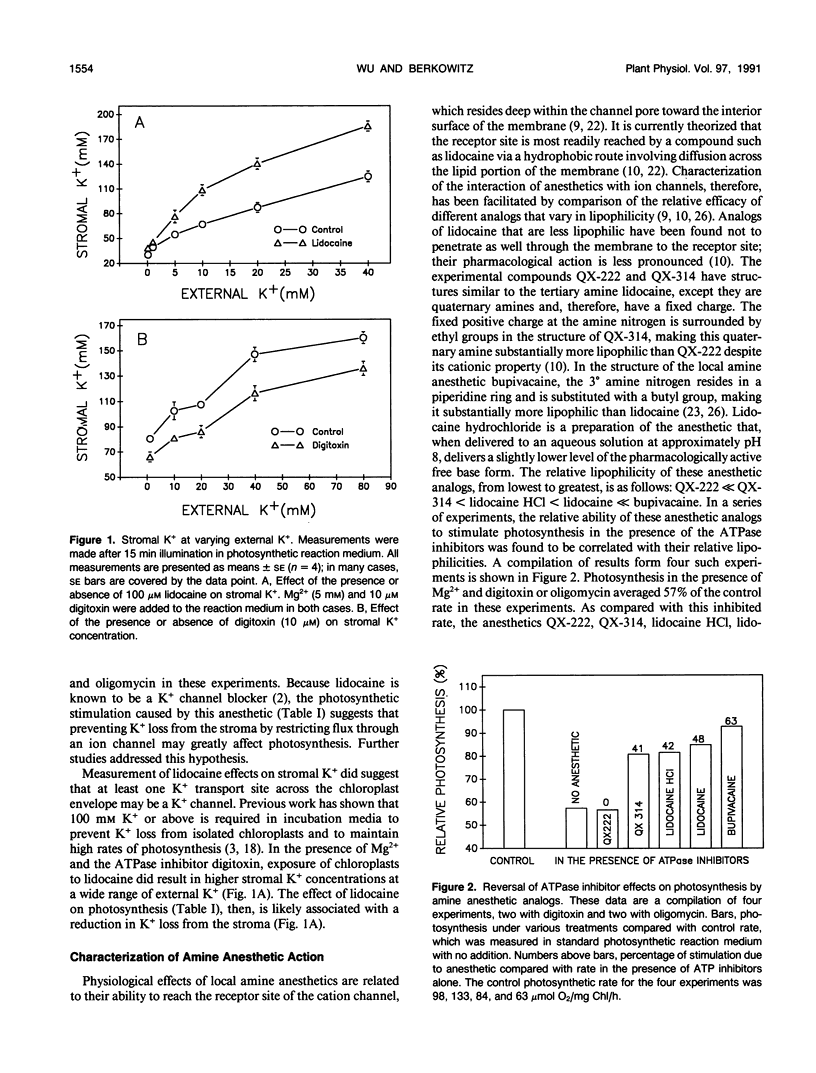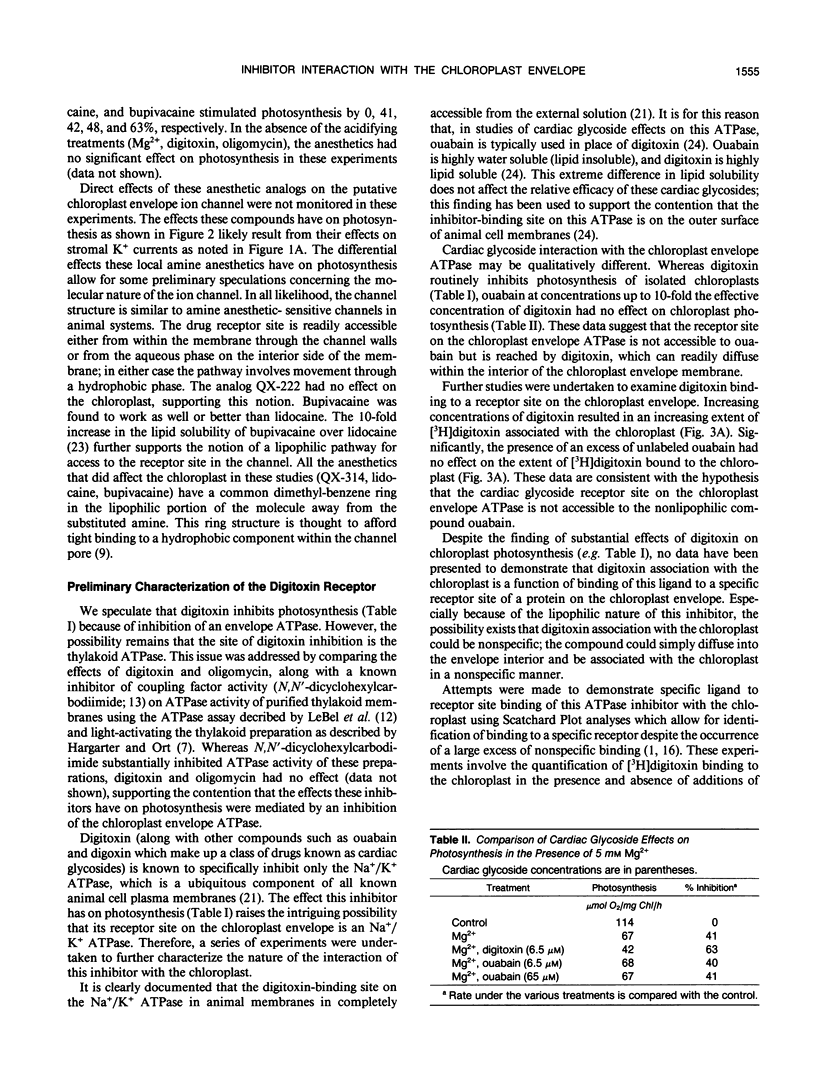Abstract
Photosynthetic capacity of isolated intact chloroplasts is known to be sensitive to K+ fluxes across the chloroplast envelope. However, little is known about the system of chloroplast envelope proteins that regulate this K+ movement. The research described in this report focused on characterizing some of the components of this transport system by examining inhibitor effects on chloroplast metabolism. Digitoxin, an inhibitor of membrane-bound Na+/K+ ATPases, was found to reduce stromal K+ at a range of external K+ and inhibit photosynthesis. Scatchard plot analysis revealed a specific protein receptor site with a Km for digitoxin binding of 13 nanomolar. Studies suggested that the receptor site was on the interior of the envelope. The effect of a class of amine anesthetics that are known to be K+ channel blockers on chloroplast metabolism was also studied. Under conditions that facilitate low stromal pH and concomitant photosynthetic inhibition, the anesthetic, lidocaine, was found to stimulate photosynthesis. This stimulation was associated with the maintenance of higher stromal K+. Comparison of the effects on photosynthesis of lidocaine analogs which varied in lipophilicity suggested a lipophilic pathway for anesthetic action. The results of experiments with lidocaine and digitoxin were consistent with the hypothesis that a K+ channel and a K+-pumping envelope ATPase contribute to overall K+ flux across the chloroplast envelope. Under appropriate assay conditions, photosynthetic capacity of isolated chloroplasts was shown to be much affected by the activity of these putative envelope proteins.
Full text
PDF






Selected References
These references are in PubMed. This may not be the complete list of references from this article.
- Beck J. S., Goren H. J. Simulation of association curves and 'Scatchard' plots of binding reactions where ligand and receptor are degraded or internalized. J Recept Res. 1983;3(5):561–577. doi: 10.3109/10799898309041948. [DOI] [PubMed] [Google Scholar]
- Demmig B., Gimmler H. Properties of the Isolated Intact Chloroplast at Cytoplasmic K Concentrations : I. Light-Induced Cation Uptake into Intact Chloroplasts is Driven by an Electrical Potential Difference. Plant Physiol. 1983 Sep;73(1):169–174. doi: 10.1104/pp.73.1.169. [DOI] [PMC free article] [PubMed] [Google Scholar]
- Douce R., Joyard J. Biochemistry and function of the plastid envelope. Annu Rev Cell Biol. 1990;6:173–216. doi: 10.1146/annurev.cb.06.110190.001133. [DOI] [PubMed] [Google Scholar]
- Gupta A. S., Berkowitz G. A. Development and use of chlorotetracycline fluorescence as a measurement assay of chloroplast envelope-bound mg. Plant Physiol. 1989 Mar;89(3):753–761. doi: 10.1104/pp.89.3.753. [DOI] [PMC free article] [PubMed] [Google Scholar]
- Hangarter R., Ort D. R. The relationship between light-induced increases in the H+ conductivity of thylakoid membranes and activity of the coupling factor. Eur J Biochem. 1986 Jul 1;158(1):7–12. doi: 10.1111/j.1432-1033.1986.tb09713.x. [DOI] [PubMed] [Google Scholar]
- Heldt W. H., Werdan K., Milovancev M., Geller G. Alkalization of the chloroplast stroma caused by light-dependent proton flux into the thylakoid space. Biochim Biophys Acta. 1973 Aug 31;314(2):224–241. doi: 10.1016/0005-2728(73)90137-0. [DOI] [PubMed] [Google Scholar]
- Hille B. Local anesthetics: hydrophilic and hydrophobic pathways for the drug-receptor reaction. J Gen Physiol. 1977 Apr;69(4):497–515. doi: 10.1085/jgp.69.4.497. [DOI] [PMC free article] [PubMed] [Google Scholar]
- Huber S. C., Maury W. Effects of Magnesium on Intact Chloroplasts: I. EVIDENCE FOR ACTIVATION OF (SODIUM) POTASSIUM/PROTON EXCHANGE ACROSS THE CHLOROPLAST ENVELOPE. Plant Physiol. 1980 Feb;65(2):350–354. doi: 10.1104/pp.65.2.350. [DOI] [PMC free article] [PubMed] [Google Scholar]
- LeBel D., Poirier G. G., Beaudoin A. R. A convenient method for the ATPase assay. Anal Biochem. 1978 Mar;85(1):86–89. doi: 10.1016/0003-2697(78)90277-4. [DOI] [PubMed] [Google Scholar]
- Linnett P. E., Beechey R. B. Inhibitors of the ATP synthethase system. Methods Enzymol. 1979;55:472–518. doi: 10.1016/0076-6879(79)55061-7. [DOI] [PubMed] [Google Scholar]
- Maury W. J., Huber S. C., Moreland D. E. Effects of Magnesium on Intact Chloroplasts : II. CATION SPECIFICITY AND INVOLVEMENT OF THE ENVELOPE ATPase IN (SODIUM) POTASSIUM/PROTON EXCHANGE ACROSS THE ENVELOPE. Plant Physiol. 1981 Dec;68(6):1257–1263. doi: 10.1104/pp.68.6.1257. [DOI] [PMC free article] [PubMed] [Google Scholar]
- McCarty D. R., Keegstra K., Selman B. R. Characterization and localization of the ATPase associated with pea chloroplast envelope membranes. Plant Physiol. 1984 Nov;76(3):584–588. doi: 10.1104/pp.76.3.584. [DOI] [PMC free article] [PubMed] [Google Scholar]
- Neuburger M., Joyard J., Douce R. Strong binding of cytochrome C on the envelope of spinach chloroplasts. Plant Physiol. 1977 Jun;59(6):1178–1181. doi: 10.1104/pp.59.6.1178. [DOI] [PMC free article] [PubMed] [Google Scholar]
- Peters J. S., Berkowitz G. A. Studies on the System Regulating Proton Movement across the Chloroplast Envelope : Effects of ATPase Inhibitors, Mg, and an Amine Anesthetic on Stromal pH and Photosynthesis. Plant Physiol. 1991 Apr;95(4):1229–1236. doi: 10.1104/pp.95.4.1229. [DOI] [PMC free article] [PubMed] [Google Scholar]
- Schwartz A., Whitmer K., Grupp G., Grupp I., Adams R. J., Lee S. W. Mechanism of action of digitalis: is the Na,K-ATPase the pharmacological receptor? Ann N Y Acad Sci. 1982;402:253–271. doi: 10.1111/j.1749-6632.1982.tb25746.x. [DOI] [PubMed] [Google Scholar]
- Tucker G. T., Mather L. E. Clinical pharmacokinetics of local anaesthetics. Clin Pharmacokinet. 1979 Jul-Aug;4(4):241–278. doi: 10.2165/00003088-197904040-00001. [DOI] [PubMed] [Google Scholar]
- Wallick E. T., Schwartz A. Interaction of cardiac glycosides with Na+,K+-ATPase. Methods Enzymol. 1988;156:201–213. doi: 10.1016/0076-6879(88)56022-6. [DOI] [PubMed] [Google Scholar]
- Werdan K., Heldt H. W., Milovancev M. The role of pH in the regulation of carbon fixation in the chloroplast stroma. Studies on CO2 fixation in the light and dark. Biochim Biophys Acta. 1975 Aug 11;396(2):276–292. doi: 10.1016/0005-2728(75)90041-9. [DOI] [PubMed] [Google Scholar]
- Wheeler D. M., Bradley E. L., Woods W. T., Jr The electrophysiologic actions of lidocaine and bupivacaine in the isolated, perfused canine heart. Anesthesiology. 1988 Feb;68(2):201–212. doi: 10.1097/00000542-198802000-00005. [DOI] [PubMed] [Google Scholar]


